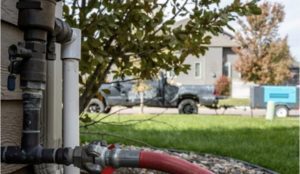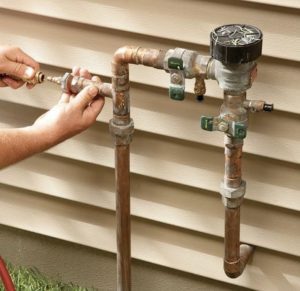Winterizing your sprinkler system is a crucial task for homeowners and professional landscapers, especially on Vancouver Island, where the climate can be pretty mild but with the occasional cold snap. Failing to winterize your irrigation system properly can lead to costly damage and repairs. In this guide, we’ll walk you through when and how to winterize your sprinkler system and provide practical examples to make the process clear and manageable.

Understanding Vancouver Island’s Climate
Vancouver Island enjoys a relatively mild coastal climate, with mild winters compared to the rest of Canada. However, winter temperatures can still drop significantly, especially in the northern regions of the island. As a professional landscaper, it’s essential to consider your local microclimate and specific weather conditions when deciding when to winterize the sprinkler system for each client.
When to Winterize
The ideal time to winterize your sprinkler system on Vancouver Island is generally in late October to early November. By this time, the risk of freezing temperatures increases, making it essential to safeguard your irrigation system. However, it’s important to monitor local weather forecasts and temperatures, as the first frost may occur earlier or later than usual.

The Winterization Process
- Turn Off the Water Supply: Begin by shutting off the water supply to the sprinkler system. This ensures that no water flows into the pipes during the winter.
- Drain the System: Open all the manual drain valves and use the compressed air method to blow out any remaining water from the pipes. This step is crucial to prevent freezing and damage.
- Insulate Valves and Backflow Preventers: Use insulation materials to protect essential components like backflow preventers and valves. This step is especially crucial in colder regions of the island.
- Remove and Store Sprinkler Heads: Carefully remove sprinkler heads, clean them, and store them in a safe, frost-free location to prevent damage. Be sure to label them for easy reinstallation in the spring.
- Winter Covers for Above-Ground Components: In exposed areas or colder climates on the island, consider using winter covers for above-ground components like valve boxes.
Practical Examples
Let’s explore two practical examples of winterizing a sprinkler system on Vancouver Island:
Example 1: Coastal Southern Vancouver Island In the southern regions, winterizing might not be as urgent due to milder temperatures. In late October, shut off the water supply, drain the system, and insulate critical components. You may not need to remove sprinkler heads in this region, but it’s still a good practice. Keep an eye on weather forecasts, and if an unusual cold spell is predicted, take extra precautions.
Example 2: Northern Vancouver Island In the northern, colder areas of the island, winterizing is critical. You should begin the process when the leaves change colour, around mid-October. Shut off the water supply, drain the system, insulate components, and store sprinkler heads in a frost-free location. Here, you might even consider burying your sprinkler lines deeper to protect them from freezing.
Remember, the key is to tailor your winterization strategy to the specific location on Vancouver Island and the unique needs of each landscaping project.
